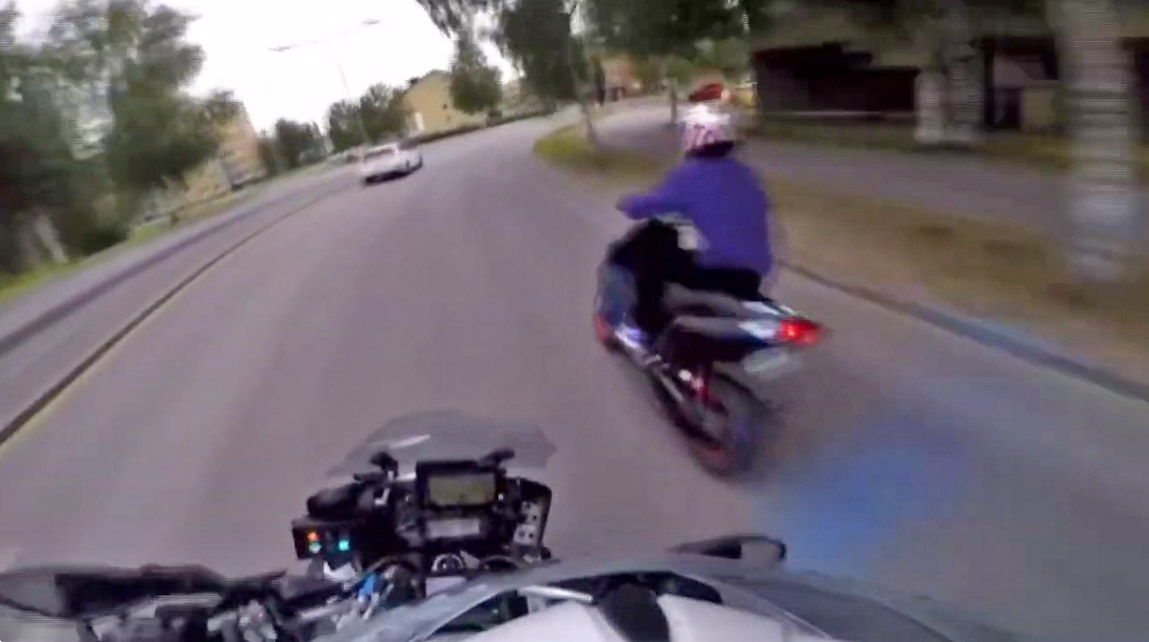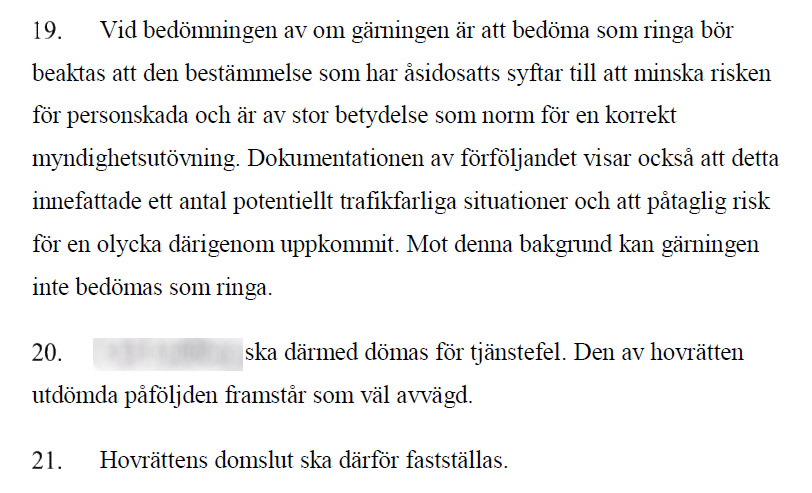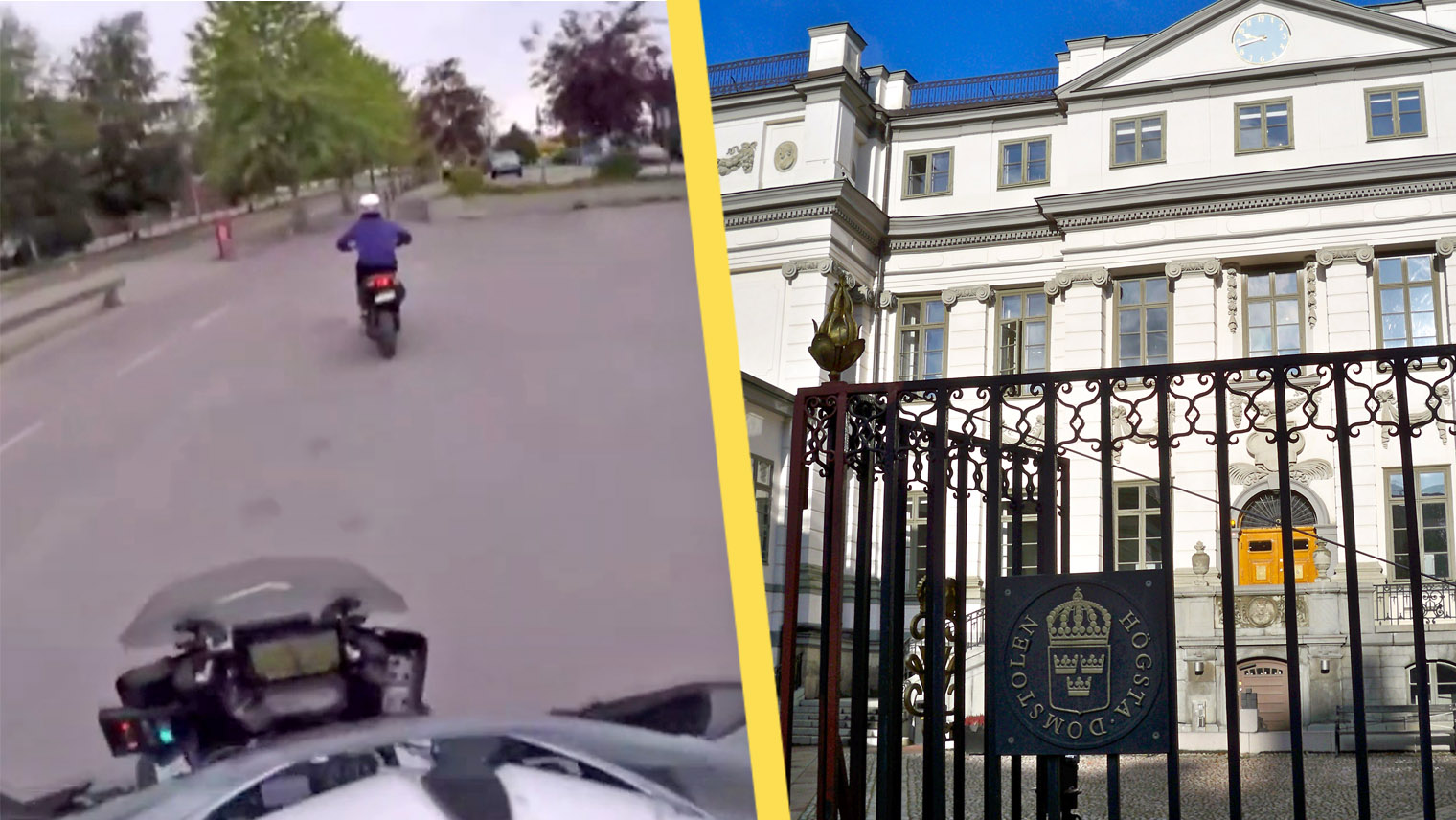After a pursuit of just under three minutes in central Piteå, a motorcycle police officer is now finally convicted of misconduct. The Supreme Court finds that he lacked “exceptional reasons” to chase the fleeing moped rider – but information in the preliminary investigation shows that he acted calmly, without putting anyone in danger.
It was an August evening in 2022 when a police patrol in Piteå spotted a moped being driven in a disorderly manner outside the police station. The driver, a 16-year-old boy, did not stop when ordered to do so by the police. Instead, when he turned and drove away, the police officer switched to a motorcycle and began a short pursuit through the central parts of the city.
The pursuit lasted for just under three minutes and was filmed with the police officer’s helmet camera. The video shows how the young driver drove on sidewalks, across parking lots, and into residential areas. The police officer followed – at a safe distance and without ramming or blocking.
According to the police’s own analysis of the video (which is part of the preliminary investigation), the traffic was sparse, and there was “no risk of an accident” at any point. The speeds were consistently between 40 and 60 kilometers per hour, although the police officer temporarily reached up to 90 km/h on open roads.
“Exceptional reasons” were lacking according to the Supreme Court
The Supreme Court states in its judgment that pursuit of two-wheeled motor vehicles – such as mopeds and motorcycles – according to police regulations, may only occur if there are “exceptional reasons”. Such reasons may exist if the driver is dangerous to the lives or health of others or is suspected of a serious crime, and not otherwise.
READ ALSO: VIDEO: Policeman blamed when chased moped rider fell
Since the fleeing boy was only suspected of serious illegal driving – an offense that carries a maximum of six months’ imprisonment in the penalty scale – the court found that the necessary conditions were not met.
“By initiating and continuing the pursuit, the police officer has disregarded what was required for the task in his exercise of authority,” the Supreme Court wrote.
Thus, the Court of Appeal’s judgment was upheld: the police officer is convicted of misconduct and fined.
Supreme Court: Could not blame ignorance
The police officer himself claimed during the process that he was unaware of the changed wording of the regulations in force – he had been away from the police profession for a while and believed that he was acting within the framework. But the Supreme Court considered that his training as a motorcycle police officer meant that he should have understood that the rules were strict.

Justice Petter Asp wrote in an addition that ignorance of the law is rarely an excuse for a public official: a mistaken belief about what is required for the task may be relevant to the question of negligence, but does not excuse the action itself.
Preliminary investigation: Low risk and calm intervention
The preliminary investigation, led by Special Investigations, provides a more nuanced picture of the events than the legal assessment. According to the police’s own analysis video from the incident, the police officer did not make any dangerous maneuvers, did not attempt to block or ram the moped, and instead tried to maintain a steady speed and distance to reduce the risk of an accident.
Investigator Jesper Rundeberg wrote: “At no point does it seem that an accident is imminent. The police officer seems to have the tactic of driving alongside to get the moped rider to stop and give up.” The weather and traffic situation also spoke for low risks – there was sparse traffic and few people outside.
The young moped rider: “I got stressed”
In interrogation, the 16-year-old claimed that he initially did not understand that it was a police officer ordering him to stop, and that he then “got stressed” when the blue lights and sirens were turned on and therefore did not stop.
READ ALSO: VIDEO: Here the police ram moped riders – fly several meters
He drove between sidewalks and parking lots, but claimed that he had “good visibility” and did not believe he was putting anyone in danger. The moped was tuned to a top speed of about 67 km/h. “I just thought that I would continue driving,” he said in interrogation.
The police’s motive: Wanted to stop dangerous driving
The police officer has always maintained that his intention was to protect other road users. According to him, the moped had been seen driving recklessly outside the police station, and it was important to quickly identify and stop the driver before anyone was injured.
He perceived the situation as involving serious illegal driving, and therefore acted under the belief that the pursuit was justified.
Misdemeanor or not?
The district court agreed with him in part: it found that the offense did indeed involve a violation of the rules but was so minor that the prosecution should be dismissed. The Court of Appeal and subsequently the Supreme Court, however, made a different assessment.

The Supreme Court emphasized that the rule about exceptional reasons exists precisely to protect vulnerable road users from the risk of accidents, and that the pursuit could not therefore be seen as trivial.
Symbolic judgment that sparks debate
The case has raised questions about how police officers should weigh the demands of the law against their duty to intervene. A Supreme Court judgment is precedent-setting and guiding for future legal cases: even short and cautious pursuits of two-wheeled vehicles are now considered prohibited unless very strong reasons exist.
At the same time, considering the preliminary investigation, it appears that the accused police officer did not act recklessly but rather tried to minimize the risks. The punishment – a number of fines – is low but marks a fundamental limit: even well-meaning police interventions can become criminal if they violate the regulations.
The Supreme Court’s judgment establishes a legal principle that the regulations for pursuit outweigh a single police officer’s assessment in the moment. But behind the legal line is a dilemma for the legal system that has sparked debate. An experienced motorcycle police officer tried to stop a crime – and thereby unwittingly became a criminal himself.
